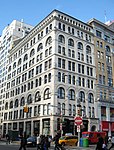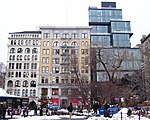Parsons School of Design, known colloquially as Parsons, is a private art and design college located in the Greenwich Village neighborhood of Lower Manhattan in New York City. It is one of the five colleges of The New School. Parsons is consistently ranked one of the best art and design schools in the United States, together with MIT and the Rhode Island School of Design (RISD).Founded in 1896 by William Merritt Chase as The Chase School to support individuals’ artistic expressions, Parsons was the first of its kind in the country to offer programs in fashion design, advertising, interior design, and communication design, which it continues to offer today. It also offers undergraduate and graduate programs in a range of disciplines in art and design, such as architectural design, history of design, art history, fine art, curatorial studies, illustration, design and technology, data vizualization, product design, as well as strategic design and management. The school is recognized for its MA in History of Design and Curatorial Studies in partnership with the Cooper Hewitt, Smithsonian Design Museum, as well as its Graduate Fellowship program in impact entrepreneurship funded by the Kauffman Foundation.Parsons programs are known for combining rigorous interdisciplinary research with advanced studio practices to clarify, challenge, and communicate new realities that have either been marginalized or not yet recognized in established discourses. Students at the school investigate the conditions through which new analogies, metaphors, and models for understanding objects of enquiry can emerge, and learn to identify new relationships within complex systems. They are supported by renown theorists and practitioners in the arts. Notable faculty members include Frank Lloyd Wright, Piet Mondrian, Tim Gunn, Soon Yu, Emily Oberman, Ben Katchor, Lauren Redniss, James Romberger, Charlotte Shulz, and Peter Kuper. Many of whom have been a recipient of MacArthur ‘Genius’ Fellowships, Guggenheim Fellowships, Eisner Awards, and other industry awards.
The school has produced cutting-edge scholarship for over a century, and it continues to do so through its university research centers. Design, innovation, and sustainable development are overarching themes at research centers such as the Visualizing Finance Lab, which explores how narrative visualization can help individuals improve their financial literacy and financial behaviors, the DEED (Development through Empowerment, Entrepreneurship, and Design), which focuses on the future of indigenous artisans and their children, the PETLab (Prototyping, Education, and Technology Lab) for public interest game design and interactive media, the E-Lab, a design-driven business lab for entrepreneurship, the DESIS Lab (The Design for Social Innovation and Sustainability Lab), and the Healthy Materials Lab.Other research centers study how arts-based methods for participatory action research can activate social and political participation. This includes the Tishman Environment and Design Center, which investigates how bold design, policy, and social justice approaches to environmental issues can advance just and sustainable outcomes in collaboration with communities, the Vera List Center for Art and Politics, the Center for New York City Affairs, as well as the Housing Justice Lab for equitable neighborhood development.Among Parsons alumni are artists, designers, entrepreneurs, photographers, architects, illustrators, fashion designers, graphic designers, theorists, and critics who have made significant contributions to their respective fields.
The college is a member of the National Association of Schools of Art and Design and the Association of Independent Colleges of Art and Design.







